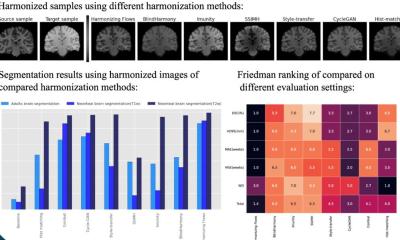Cardiac MRI at 7-Tesla
During conventional electro-cardiology, interference from electromagnetic fields (EMFs) tends to diminish image quality due to cardiac motion. To exclude that interference an acoustic cardiac triggering (ACT) approach, also called MR stethoscope, has been developed to trigger cardiac MRI at 7-Tesla.


Developed by researchers at the Experimental and Clinical Research Centre (ECRC) in Berlin-Buch, Germany, the new technology will soon enable cardiac characterisation at tissue-level and promises to bring new insights into cardiac function and myocardial (patho-) physiology.
Due to the heart's location in the middle of the thorax, surrounded by inhomogeneous tissue structures, and its on-going motion, up to now precise cardiac Magnetic Resonance Imaging (CMRI) has presented a technical challenge for researchers. However, some apparently invincible problems in cardiac imaging with 7-Tesla MRI seem to be almost solved. As reported in our Online-Edition (www.european-hospital.com 11/12/09) Professor Mark E Ladd and researchers at the Erwin-Hahn Institute for Magnetic Resonance Imaging, Essen, have developed applicable radio frequency (HF) antennae and coils that allow complete penetration of the deep-lying heart with HF, which avoids HF-inhomogeneities. This is seen as an important premise to receive complete and precise images of the heart. ECG triggering, one of the remaining most difficult challenges, has now been tackled by ECRC researchers in a cooperation run by the Max Delbrück Centre for Molecular Medicine and the Charité.
ECG triggering did not work reliably with the 7-T scanner and, to some extent with the 3-T, which led to an increase of artefacts. Consequently, the corrupted images were not suitable for diagnoses. ‘To avoid artefacts due to cardiac motion and flow constraints, cardiac imaging requires high-speed, efficiency and precise synchronisation of data acquisition with the cardiac cycle,’ explained Professor Thoralf Niendorf, physicist and head of the Berlin Ultra-high Field Facility (B.U.F.F) at ECRC. ‘Up to now synchronisation was achieved by using ECG to trigger the MRI. Indeed, being an electrical measurement, ECG brings along the risks of interference with the MR-system, inter alia by electromagnetic and magneto-hydrodynamic effects. This interference increases with increasing magnetic field strength. The stronger the magnetic field, the higher the probability of artefacts in the ECG-trace; in other words instead of a precise ECG-recording, we receive a knitting pattern. Consequently, there will be an erroneous triggering and therefore a blurred image.’
Thus the research team developed an alternative method to trigger the MRI-scanner -- Acoustic Cardiac Triggering (ACT). ‘We were – in another, relatively new field of MR-application -- phonetics – discussing how to scan the larynx and movement of vocal folds,’ Prof. Niendorf continued. ‘I came across the idea of using acoustic signals to detect motion.’ The researchers transferred this concept to cardiac MRI and began a collaboration with cardiologist Professor Jeanette Schulz-Menger, at the HELIOS Hospital, in Berlin-Buch, to examine the applicability and clinical efficacy of MR-Stethoscopes to cardiac MR at 7-T.
The MR-Stethoscope consists of four elements: an acoustic sensor, acoustic waveguide, signal processor and a coupler linked to the MRI system. Like the chest piece of a common stethoscope, when located on a patient’s chest the acoustic sensor registers cardiac sounds. In a specially developed procedure the acoustic signals are transformed into a trigger signal, mimicking the basic waveform of an ECG. The MR-Stethoscope is compatible with common MRI-scanners and does not need any hard- or software changes.
A first clinical study (published: European Radiology online. 12/09) showed proof of concept by comparing left ventricular function assessment using ECG and ACT triggered MR-Imaging at 1.5-T and 3-T. Meanwhile, Prof. Niendorf’s and Prof. Schulz-Menger’s team studied the feasibility of acoustic triggering at 7-T, using a whole-body human MR scanner with an 8-channel transmit-system at the Berlin Ultrahigh Field Facility (B.U.F.F). They received exciting results: ‘We achieved reliable and accurate CINE images of the beating heart with sharp contours. We can ensure, at 7-T, the standard we know from MR-Imaging at lower magnet fields. Testing the different methods the failure rate with ECG-triggering at 1.5-T came to a negligible 5% but, at 7.0-T, the rate was 40%. However, the MR-Stethoscope eliminated those failure rates,’ said Prof. Niendorf.
Prof. Schulz-Menger added: ‘With appropriate radio frequency coils and triggering devices in place we hope to achieve a kind of in vivo microscopy. In other words, we will examine and characterise the myocardial tissue with, up to now, unmatched precision. We can already achieve an in-plane spatial resolution of 1mm2, together with slices as thin as 2.5 mm with the 7-T scanner. You can even see subtle anatomical features, such as trabeculae and the right ventricle, in great detail, all in a non-invasive way, excluding harmful radiation exposure.’
Cardiac MRI at 7-T is expected to advance the ability to differentiate myocardial diseases, e.g. inflammation, or fibrosis, and to monitor disease processes. Considering the challenges and opportunities, Prof. Niendorf pointed out: ‘By reminding us that previous limits on resolution, speed, and contrast are not fundamental, our efforts and results encourage us to connect basic research to clinical applications -- and vice versa. Whilst today’s (ultra) high-field CMR techniques remain in a state of creative flux, productive engagement in this area continues to lead us into the heart of the matter.’
Worldwide, 7-T scanners are still confined to research; they are not licensed for clinical routine. Besides – these scanners, with the strength of about 1,500,000 times that of the earth’s magnetic field (between 30 to 60 micro-tesla) are currently too expensive for clinical use: the 7-T scanner at B.U.F.F, for example, costs around €8 million. Despite these constraints, Prof. Niendorf and Prof. Schulz-Menger are convinced that their research will bring important knowledge of heart disease risks factors and disease processes – all of which could help to develop new diagnostic strategies and therapies.
17.05.2010










